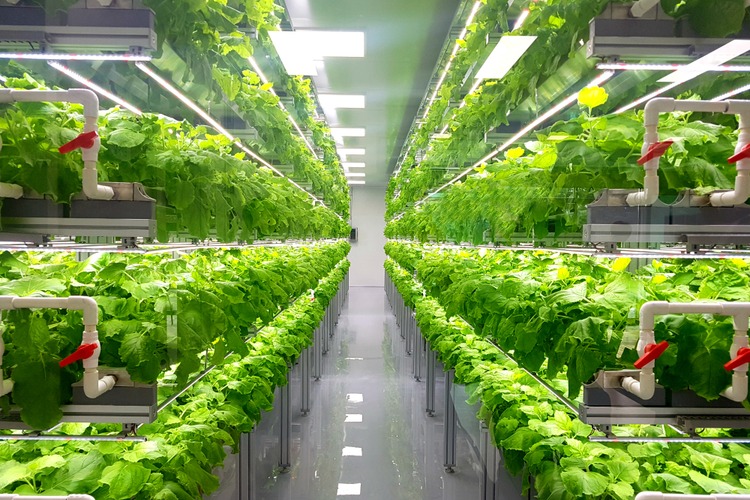 1. Hydroponics (Growing Plants Without Soil)
1. Hydroponics (Growing Plants Without Soil)
Hydroponics is a predominant system of growing that is used in vertical farming, and it is slowly but steadily, gaining importance. It involves around the growth of plants in solutions of nutrients that are essentially free of soil. In this vertical farming innovation, the roots of the plants are submerged in a solution of nutrients. This is frequently circulated and monitored in order to ensure that there is the maintenance of the correct chemical composition in the nutrient solution.
2. Aquaponics (An Ecosystem that Promotes Plants and Fish Farming Together)
An Aquaponics System is much like the Hydroponics System but is only better. It aims to combine the fish and plants in the same ecosystem. In this system, fish grow in indoor ponds and produce a nutrient-rich waste that further acts as a food source for the plants grown in vertical farms. The plants, doing their part, purify and filter the wastewater that gets recycled directly to the fish ponds. Aquaponics is definitely used at a smaller scale than most vertical farming innovations. However, it is still used by many commercial vertical farms that wish to produce just a few fast-growing crops instead of including the component of aquaponics. As a result, the production and economics issues are simplified and it also maximizes efficiency.That said, this closed-cycle system might become more popular with the popularity of new standardized aquaponic systems.
3. Lokal (Serving Fresh Food Right Where Its Grown)
The Space 10 innovation lab of IKEA came up with the idea of Lokal that uses a Hydroponic farming system. It also uses LEDs to have your kitchen garden in stackable trays. According to the designers of Lokal, the greens grow three times faster in Lokal than traditional gardens. They are also testing another innovation wherein they will integrate sensors into the growing trays, which will help you check the status of the crops with the help of smartphones or Google Homes. In the long run, they also want to use machine learning to collect and analyze data from the people using Lokal to assess the productivity. This innovation can really help people grow fresh food in their own local mini-farms.
4. AeroFarms (The Smart Vertical Farming Innovation)
When it comes to indoor farming, AeroFarms are the commercial leaders in this field with their innovation of using the aeroponic system of farming that ensures predictable results of your harvest, less impact on the environment, faster harvesting period and superior quality of food. The technology helps growing greens without using any sun or soil. Therefore, it is easier to control the results of the harvest. The vertical farming innovation makes use of smart light, smart aeroponics, smart nutrition, smart data, smart pest management, smart substrate and smart scaling. AeroFarms aims to transform the whole system of agriculture by building and making farms that are environmentally responsible. They are building farms around the world to make sure there is a local production of food that is nutritious, safe, sustainable and delicious.
5. VertiCrop (A Sustainable Farming Technique for Urban Areas)
VertiCrop is a proprietary agriculture technique that has been deemed as one of the Worlds Greatest Inventions by TIME Magazine in 2009. This patent pending technology was designed and developed so that food could be grown naturally in the environment of bustling urban areas. This proprietary method offers quite a paradigm shift in food production and sustainable farming methods. It provides up to twenty times the yield of your standard field crops and uses merely 8% of the water that is usually needed for soil farming. The vertical farming innovation works on a suspended tray configuration that is unique in itself and moves on a conveyor system. VertiCrop offers optimal exposure to both artificial and natural light in addition to nutrients that are precisely measured for every plant. It has been designed in a way that it can promote the healthy growth of crops in controlled and closed-loop environmen. Furthermore, it entirely gets rid of the need for using harmful herbicides and pesticides and maximizes food value, nutrition and above all taste.
6. Modular Farms (Produce Fresh Plants Virtually Anywhere in the World)
The very exclusive and sustainable Modular Farm System is another great innovation in the world of vertical farming from the company called ModularFarms. It is an entirely indoor system of vertical farming that has the ability to produce healthy and fresh plants virtually in any climate and anywhere in the world. If that does not intrigue you enough, it is a custom-built design that is based on an urban farm idea. This modular farm scales according to need and has additional modules that are available for diverse purposes. The Modular Farm System concentrates solely on farmer ROI and plant health. This system is the perfect pairing of container farms, and the tried & tested technology of vertical farming. This balance between the two promotes an endless growth of fresh and locally produced plants. A highlight of this vertical farming innovation is that you can customize your system and extend its functionality according to your agriculture needs to accommodate any sized operation.
7. Skyfarm (A Wind-Powered Vertical Farming Tower)
An architectural firm, Rogers Stirk Harbour and partners from London demonstrated a concept called Skyfarm during the World Architectural Festival in 2014. The idea is to build a hyperboloid tower that makes use of different farming techniques including aquaponics and traditional soil-based planting methods to produce crops within high-density urban areas or at places where land availability is less. The multi-story building uses bamboo to create a rigid circular frame while maximizes the sun exposure onto the farm. The tower supports both the growth of crops and fish together through a re-circulating system where the nutrients from fish water are fed to the crops while the plants provide filters for the fish to thrive. The bottom of the tower is designed to have a large transparent tank consisting of freshwater for the farming of fishes like bass, tilapia, and barramundi. In the middle of the tower, the plants are grown through hydroponics using water. Above this, the plants are grown through aeroponics using only water mists and no soil. The top of the tower consists of water tanks and turbines. The tower is an example of a sustainable solution for growing produce with a short shelf life around the year with easy accessibility for the urban population.
8. Sky Greens (The Worlds First Hydraulic Driven Vertical Farm)
The Singapore-based company Sky Greens has developed a revolutionary vertical farming system which is also the worlds first low carbon, hydraulic driven farm. The vegetables are planted on shelves that keep on rotating throughout the day. The plants at the bottom receive water, while the ones at the top get sunlight and the process continues. This approach minimizes the use of water, land, and energy over the conventional farming techniques. In addition, the Sky Urban Vertical Farming System is capable of producing 10 times more yield compared to traditional farms. While the system is currently used to grow Asian vegetables, it can also be used to grow all kinds of fruits and veggies. Vertical farming is definitely an attractive option for farmers these days as more and more industry experts embrace it and for a good reason. It promises a much more sustainable way of farming in addition to not just producing quality produce but also cutting down on costs and making agriculture more eco-friendly. These innovations are bound to rise in popularity and revolutionize the face of vertical farming in the future.
